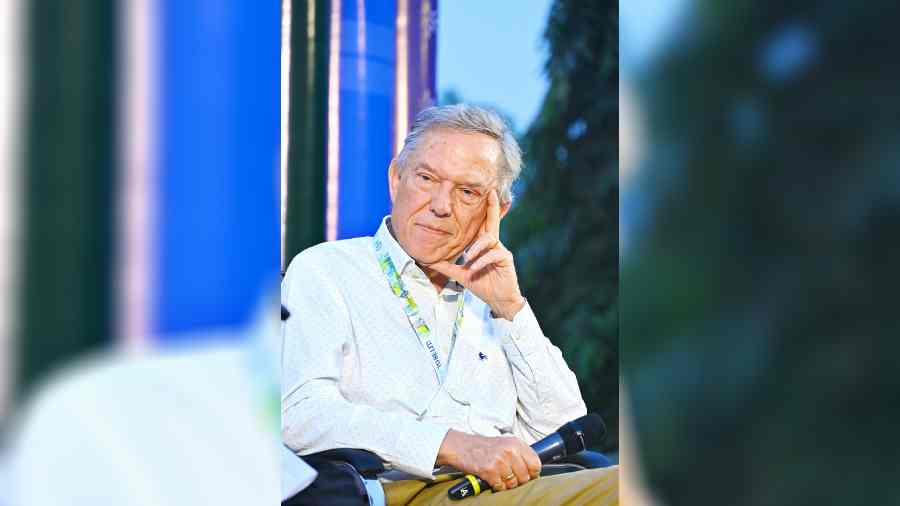The first time T. Richard Blurton came to India was in 1970 and then he kept coming back for the next 53 years. That day, he sits on the podium hunched and squirming under the arc lights answering questions about his recently published book India: A History in Objects. His responses come from a certain authority and understanding of the country of his chosen interest.
His sumptuously illustrated book — 500 illustrations to be precise — tells the history of South Asia through a close reading of objects from Pakistan, Bangladesh, Nepal, Sri Lanka and India.
To begin with, Blurton worked as a field archaeologist in the Mediterranean, in south Afghanistan and also in southern India. He says, “My training was in objects — picking up an object, looking at it from all sides and describing it, thinking how it was made, how it was used and how it deteriorated over time. All these are categories of thinking you develop as an archaeologist. But that long period of working in the field prepared me to work in a museum which has a large collection of objects that can tell stories.”
Blurton describes his book as a “brain dump” that came out of 32 years of working both in public galleries and in the reserve collection of the British Museum.
The first object in the book goes back 1.5 million years — a hand axe from Attirampakkam near present-day Chennai. The last object is from 2018. “This is an immense stretch of chronological time, an immense stretch of artistic and cultural development and change,” he says.
The 71-year-old swings back and forth between book and personal memories. One thread works in- to another and a pattern begins to emerge.
Blurton talks about the time when soon after he joined the British Museum, he found a scroll deep inside a cupboard. It was a painted scroll collected from Bengal by J.C. French, an ICS officer in the 1920s. It was over nine metres long and there were 53 painting registers. He tells The Telegraph, “I spent a number of years working on that. This got me hooked and made me realise that a lot of Indian art can be explained as the presentation of narrative.”
He starts to talk about the interconnectedness of histories — how Indian cotton was exported in the early Roman period, examples of Indian durries in central Asia and “magnificent textiles of India” turning up in different islands of Indonesia. His book has a photograph of a textile with female figures playing the veena block printed on it. “The cloth was found in Sulawesi, which is an island in Indonesia. It is very clear that the textile came from Gujarat in the 16th century because the female figures are clearly based on Jain manuscripts and paintings,” says Blurton.
From time to time the conversation turns to museums with large international collections. He says the future lies in making such holdings accessible to as many people as possible, both virtually and actually. Lending has been and will continue to be a major element, and digital representation of collections is another important element, he adds.
When asked what he would have included in his book if he had access to a South Asia collection, the silver-haired sprightly curator says, “One would have to include sculptures from Bharhut.” Sections of the Bharhut stupa were supposed to go to the British Museum but the British curators of the Indian Museum insisted that they must be here and so the collection remains here.
To the widespread allegation that the British Museum secured vast quantities of “loot”, Blurton says, “But London had little interest in Indian culture in the 19th century.” He says, “If we had been as acquisitive in South Asia as we were in the Greek and Roman world, there would be some justification assuming that a great deal had gone to London. Of course, we have sculptures from Amravati. But a greater collection of Amravati is in the Chennai Government Museum and in the site museum near Vijayawada. And having that collection in London does mean an international audience of six million visitors every year are getting to see it, most of who would never be able to travel to India. Besides, there is a huge Indian community in the UK for whom this is their heritage.”
One of the highlights of Blurton’s career was bringing an exhibition to India in 1997 comprising 300 items from the British Museum. The exhibition was shown in Delhi and Mumbai. Also important was a Bengal Season in 2006, which included collaboration with the Crafts Council of India.
The conversation now turns to the repatriation of objects. He says in his entire career he has witnessed only one item being returned — to Tasmania. “It was a bag of human ash from a cremation. Our trustees debated whether the demands of the original community who held this material in high status were comparable with the loss to science if it was returned and the ashes then disbursed. They decided it was,” he says.
Today, a Unesco protocol is in place, which states that museums shouldn’t acquire antiquities that have left the country of origin before 1970. The British Museum has followed this protocol since then, says Blurton.
The septuagenarian wants to continue working on India; it is his passion of a lifetime which is now taking him to the textiles of Assam and the monuments in Tawang.










